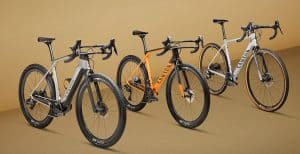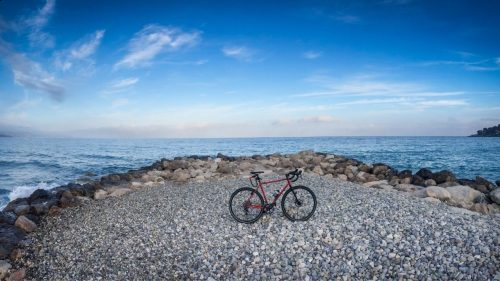When trying to find a brand new bike that fits into a specific type of riding, it can be overwhelming at times. Every kind of bike riding is slightly different, and some people go through a case of options overload.
Gravel bikes are a bit of a catch-all term for those looking for something that can perform well on both road and mountain bike surfaces. Instead of going very specific with one or the other, a gravel bike should theoretically perform well on just about anything.
Ready to narrow down the choices and see what works best? This is a detailed look at the process of shopping for a new gravel bike and understanding all the different options.
There are ways to get precisely the type of bike a person wants, all while staying under a budget. This makes the sport much more accessible to everyone, instead of being a niche sport that only a few can enjoy.
1. Think About Location, Trails, and Riding Plans First

A gravel bike has the opportunity to go just about everywhere, but most people are going to settle into a specific type of riding.
There might be some people who believe that they have these expectations that they will be riding just about anywhere when they make a new purchase, but most are going to stick with what they know. That is perfectly fine, but it can influence what type of gravel bike is purchased.
With such a wide range, one of the most significant differences between gravel bikes is catering more towards the road bike crowd and more to the mountain bike route.
For example, if a person expects to ride about 80% of the time on pavement, it just makes sense to go with a bike that looks more like a road option. If off-road riding is the norm, getting a thicker tire and a bike design for that makes sense.
Where a person lives also makes a big difference in what type of gravel bike works best. Someone who is in a very flat part of the world might not need as many gears to go up and down inclines. Instead of wasting extra money and adding weight to the mix, go with the gravel bike option a bit more catered to flat land.
When in doubt, try to stay as neutral as possible when shopping for your gravel bike. This is especially true for beginners because they might not know as much about what type of riding they will ultimately do. If a person can’t specialize, it just makes more sense, so do not rule that out.
2. Test out Different Gravel Bike Geometry

Bike geometry is one of the only things that can’t really change after the fact, which is why it is so essential to work on getting the right fit from the beginning. There are some basics to a gravel bike as far as geometry is concerned, but some slight variations can make a pretty big difference.
The most important figure with a bike geometry is the trail. This is the combination of the fork offset as well as the head angle. If a trail figure is big, it will feel a lot like a mountain bike. That means the bike will feel a little more stable for the vast majority of riders, but the handling might not be as precise.
Those wanting quicker handling will usually opt for smaller trail figures. It is going to feel a lot more like a road bike, but a person does lose a bit of stability when they pick up speed.
Bike geometry matters when it comes to how a person sits on the bike as well. Some adjustments are possible, but most people want to be in a very comfortable position the entire time.
Gravel bike rides can sometimes last for most of the day, and not having something set up correctly can do some damage to the body. Too many people do not take the time to make these tweaks, and it comes back to haunt them.
Sizing matters with bikes, as no one wants to feel like they are fighting against a bike when they are riding. Make sure to go off of the measurements and guidelines to get a rough sizing initially, and then have it tweaked to get that tailored fit.
Again, having the right layout is going to make life so much easier for people and keep them as injury-free as possible. Too many people end up overextending themselves or cramping themselves up by not getting their bike properly fitted.
3. Find Frame Material That Works
Frame material does not matter as much with a gravel bike as it does in other types of bikes. With that said, it does influence the overall price of the bike and its weight.
The higher-end options are going to have a lot of carbon on them, while cheaper options are usually made of aluminum or steel.
The majority of gravel bike riders are not necessarily going for time, so they do not need to invest in a bike that has cutting edge technology with the frame. It just needs to be strong enough that it can hold up for a long period of time.
Remember, this is the core of the bike and something that can’t be replaced without replacing the entire bike. Invest in a frame that will still be a solid choice a year or two from now. All the other components can be upgraded as a person moves along.
Finally, a good bike frame for a gravel bike will have the opportunity to carry bags safely and without any stress. The longer a person goes on a ride, the more bags that they will bring with them. Do not get a bike that will not have the chance to support a lot of weight along the way.
4. Understand the Different Component Specifications

Getting solid stock options for components from the very beginning is going to cut down on having to make purchases later on. There is always a way to upgrade components to a certain degree, but not everyone wants to deal with that. The better way to go, especially with a first gravel bike, is to spend the money on specifications that matter.
The drivetrain is one of the biggest decisions a person can make with a gravel bike. Those who are going to spend more time on flat surfaces and attacking hills might opt for a 2X drivetrain.
It will help with having a good gear range overall, with the gap in between the gears very manageable. Almost all rode bikes use this type of system, which is why gravel bike users will stick with it as well.
Electronic drive trains are also an upgrade that might prove beneficial for some people that want the latest state of the art bike tech!
If off-road riding is the way to go, a 1X drivetrain is going to be fine. Couple it with a clutch rear derailleur, and everything should be good to go. It only has one front chainring, but it has fewer stops in between. It is a more straightforward setup, and it allows for pretty massive changes in a short amount of time.
The other major components are not as specific, but certain companies do better than others. For example, brakes are something that is best to read about by combing through online reviews. They will cover the types of brakes that certain manufacturers will use, and whether or not they can live up to expectations.
Replacing the brakes is also possible, but most people do not want to deal with that hassle. As long as the brakes are working and dependable, most will stick with the stock option.
Other upgrades can be anything from new pedals to a whole new fork. It can get pretty expensive to upgrade specific components to the point that it might make more sense to upgrade the entire bike.
Some people enjoy the ability to customize a bike to their liking and buy components little by little, while others find it to be a bit tedious. For those who are starting now, try to get something as ready-made as possible, so take the extra time to research components and see what works best.
5. Find Appropriately Sized Tires

There is enough space to put in a wide array of tires specifically for gravel bikes. This is good news for people who want to use their bikes for different surfaces, as they have the opportunity to size down or go up.
Most of the time, gravel bikes are going to come with pretty neutral tires, but as a person rides more and more, they might believe that it is worth upgrading.
If the majority of riding ends up being on the road, going with a thinner tire makes sense. It is going to speed up the bike, and more air can be put in a tire to make it very firm. It is not going to be so skinny that it can work off road, but it is mostly going to mimic a road bike by design.
A thicker tire is going to make for a more comfortable ride on rough terrain. With more surface area touching the ground, it smooths things out and absorbs shock very well. As long as a person does not over inflate the tires, it helps with absorbing shock as well.
The width of a tire is one factor, but some bike options allow for slightly different sizes as well. It is hard to decide to start with a gravel bike. But once miles are logged, people can start to decide what type of tires they might upgrade to. It is important to shop for a bike that has a wide range of bike width options because then people do not have to feel too restricted.
6. Test Ride As Many Options As Possible
Buying a gravel bike online is extremely enticing, but there is one important aspect that is hard to replicate without going to an actual store. There is something to be said for actually test riding any gravel bike that is under consideration, as it gives people a good idea on so many small things in a short amount of time.
A bike can seem perfect online, but this is where a person might be sitting for hours at a time. It needs to be extremely comfortable in the first hour and the 10th hour. This is why test riding a gravel bike is more important than just about any other bike out there.
Yes, every bike can be adjusted to fit a person specifically, but most people are going to get a pretty good idea of how it rides by going on a few trial runs.
Bike companies know this, which is why they have encouraged allowing customers to go out and ride the bike. In some situations, they are even encouraging people to rent out a bike to try out for a day or two. This allows people to go out on actual trails and see how it works for them. It is much more realistic to understand how a bike performs when riding in a natural setting.
After the test ride, those working in sales are likely going to push for some type of decision to perhaps make a sale. Stay strong, and do not ever feel rushed to make a decision right there.
In some cases, a person might feel like they have the right bike for them, but it is not always the case. Also the option of shopping online and looking for a better deal, so do not spend a lot of extra money in person just because of some sales pressure.
7. Ask Current Gravel Bike Riders Recommendations
At some point, every person who is currently riding a gravel bike was in the same situation as a typical shopper. They were not quite sure what to do with potential purchasing options, and they likely tested out a few different options on their own.
It is important to understand that everyone is different, but at the same time, they can help potentially uncover some reasons why they did not go with a particular bike out there.
For example, maybe they were able to test ride a particular option found online, and it was underwhelming. If they can help to make the selection process just a little bit easier, it is worth having that conversation.
Most of the community seems very willing to share information and allow people to understand what they have been going through. It might even open up an opportunity to find someone else to ride with later on once a person gets into gravel bike riding.
It does not hurt to get opinions from a few different people as well. They are going to be very unbiased, and it is different hearing straight from somebody instead of a salesman or the Internet.
Salespeople are going to be biased, and the Internet is usually full of people who are mostly having a frustrating time with a bike. More often than not, people do not leave as many reviews online about bikes that gave them no trouble.
8. Understand That Upgrades Are Possible
After making any somewhat big purchase, there are a lot of different emotions people are probably going to be feeling. Some gravel bike riders are going to be relieved that they finally made a decision, and they dive into the sport and never look back.
Others might start to nitpick their decision and realize that they should have gone with a different option. Do not look at buying any new gravel bike as a permanent solution.
There are ways to upgrade that bike in particular, and people may even upgrade the entire bike later on. This is especially true for those who are buying their very first bike. This is not going to be the one and only gravel bike ever purchased, as people will gravitate towards something else once they start to increase their ability.
Smaller upgrades are always possible with any gravel bike. Switching out a seat for the handlebars is still a pretty easy solution to make things more comfortable. Upgrading tires is another way to make a bike feel so much different, without having to go through the entire bike buying process again.
Make sure to buy a bike that has a solid base to make upgrades within the beginning. There are too many people who make the mistake of getting a bike that is cheaply made all around, and therefore not being able to make any upgrades if they would like. If a bike frame is not solid, there is very little use to do many upgrades to enhance it too much.
All in all, a person should be confident in their choice and go from there. It is going to be a learning curve with any new bike, and the truth of the matter is, no bike is 100% perfect. There is a reason why companies are always trying to come up with new technology to make them better and push the sport along.


One thought on “How To Choose A Gravel Bike – 8 Best Tips!”